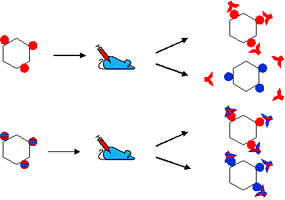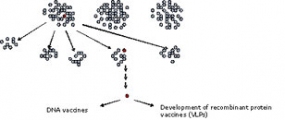Polyvalente Vakzine gegen Papillomavirusinfektionen
(Polyvalent Papillomavirus Vaccines)
Maja Gasparic, Masters Thesis
In order to prevent the infection by Human Papillomaviruses and decrease the incidence of cervical cancer, prophylactic vaccines which use VLPs consisting of the major capsid protein L1 as a basis, are currently being developed. However, neutralizing antibodies induced upon immunization with VLPs are HPV-type-specific and recognize conformational epitopes on the VLP surface specific for particular HPV type. In other words, these vaccines provide protection against only one particular HPV type (Figure 1a).

Figure 1 A) VLPs-based vaccines, that are currently being developed, have type specific epitopes exposed on their surface. Such VLPs induce production of type specific neutralizing antibodies providing the protection against one particular HPV type. B) Recombinant VLPs with recombinant epitops on their surface would induce production of cross-neutralizing antibodies providing protection against more than one HPV types.
© dkfz.de
Since cervical cancer can be caused by infection with many different HPV types, there is a need to develop polyvalent vaccines which provide a more comprehensive protection. Preferentially, one would produce a single polyvalent VLP, which is able to induce an immune response covering two or more HPV serotypes. The strategy that still has to be tested is to produce VLPs that contain recombinant epitopes on their surface, which are able to induce the production of cross-reactive antibodies (Figure 1b).

Figure 2 Synthesized oligonucleotides (red) will be introduced into hypervariable regions of L1 DNA of one HPV type. Such constructs will be then inserted into mammalian expression vector and the genetic expression library, consisting of clones containing different heterologous oligonucleotide sequences, will be created.
© dkfz.de
It has been suggested to introduce synthetic oligonucleotide sequences into hypervariabile loops of L1 DNA of one HPV type (Figure 2) and to create a genetic expression library of different oligonucleotide sequences. Some of the oligonucleotides may encode for the epitopes that can induce production of cross-reactive antibodies providing protection against a variety of HPV types. In order to identify those clones, which can be later used for the production of polyvalent vaccine, the expression library will be screened by genetic immunization (Figure 3), avoiding the expensive and time consuming production and purification of VLPs from each of created clones. Since the majority of clones will not induce relevant antibodies at all, it is a prerequisite for the screening to determine the number of clones which can be co-administrated in immunization, so that useful clones can be still identified.
For that purpose the immunization with mixtures of 2 and 4 different expression constructs, carrying the L1 gene of different PV types, was carried out, whereby the expression constructs were co-administrated at different ratios. Subsequently the sera were screened for the presence of anti-L1-specific antibodies by VLP-based ELISA and the Luminex assay. In that way the minimal amount of L1 DNA of the particular HPV type required for the induction of a specific immune response in the background of L1 DNA of another papillomavirus (PV) type can be determined. The results of these experiments indicate how many clones the library can contain that one particular clone, actually the immune response against that particular clone, can still be recognized. Furthermore these experiments may reveal if there is a difference in immunogenicity of L1 proteins of different PV types and if the presence of L1 DNA of one PV type can suppress the immune response against L1 of another co-administered PV type.

Figure 3 Screening of the genetic expression library. The expression library created from clones containing different oligonucleotide sequences are screened for the clone of interest which encodes cross-neutralizing epitope (red one). A group of clones is injected into the animals and sera are screened for presence of the cross-neutralizing antibodies. Sera, in which antibodies against different HPV types are identified, indicate that these animals were immunized with the sub-library containing the clone of interest. The sub-library is further divided into smaller sub-libraries, and steps of immunization and screening the sera are repeated. Dividing and screening for sub-libraries is repeated until the single clone of interest is isolated.
© dkfz.de
